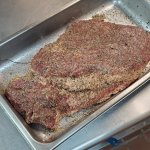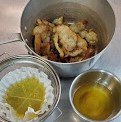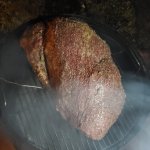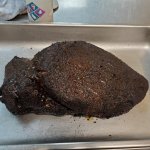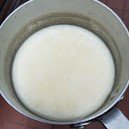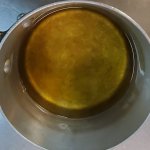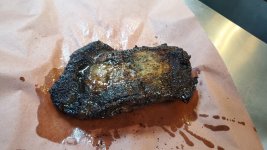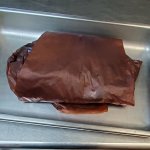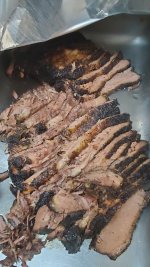Jumping off from this recent post: https://tvwbb.com/threads/brisket-injection.85732/
I'm not big on fads, but maybe you've noticed that the use of beef tallow when cooking brisket to promote moist meat seems to the current fad of the day. "Mad Scientist BBQ" on YouTube believes that the secret of Aaron Franklin's delicious brisket is the application of melted beef tallow to the pink butcher paper when the meat is wrapped for the last part of cooking in the pit, and then again when the brisket is rewrapped in fresh, beef tallowed pink butcher paper for the resting period before serving.
It's not my habit to watch other people's barbecue videos, but Harry Soo's first video on this subject popped up in my Facebook feed and I watched it, then I went back and watched the one from Mad Scientist BBQ. In the comment section of Mad Scientist BBQ's video, someone named John Pafford mentioned seeing an old episode of Andrew Zimmern's "Delicious Destinations" in which Zimmern visited Franklin BBQ. "Showed Aaron wrapping a brisket that was really wet and soaking through the paper and next to him was a steam table pan full of a light brown liquid that could only be beef tallow!"
I found that show on Xfinity On Demand and took these photos.
![IMG_2005[1].JPG IMG_2005[1].JPG](https://tvwbb.com/data/attachments/24/24608-884b1784a858222f2f5961c0102899c8.jpg?hash=iEsXhKhYIi)
In this photo, you can see that the brisket looks moist, but there's not a lot of liquid on the butcher paper. Aaron's hands don't look oily.
![IMG_1998[1].JPG IMG_1998[1].JPG](https://tvwbb.com/data/attachments/24/24604-0fd6850c3a7d9b93d10d994c1ef6f99e.jpg?hash=D9aFDDp9m5)
In this photo, the paper is folded over the brisket and the paper is very damp. We see the steam table pan of brown liquid in the background with the lid removed and placed on top of the other pan. We don't see a brush or squirt bottle, and again Aaron's hands don't appear to be oily. There appears to be a yellow spray bottle in the bottom right corner of the picture.
![IMG_2001[1].JPG IMG_2001[1].JPG](https://tvwbb.com/data/attachments/24/24605-a43454c33e9a68679e4b2c547da9c482.jpg?hash=pDRUwz6aaG)
When we zoom in, it looks like the outside surface of the paper has been wetted. Liquid is dripping down the outside edge of the paper and there are two oily streaks on the table.
![IMG_2002[1].JPG IMG_2002[1].JPG](https://tvwbb.com/data/attachments/24/24606-310bd91d047ed01f1949c6cea0866a26.jpg?hash=MQvZHQR-0B)
And here we see the wrapped brisket going back into the smoker, with the butcher paper looking very wet.
![IMG_2004[1].JPG IMG_2004[1].JPG](https://tvwbb.com/data/attachments/24/24607-a5f02e45b995b825a572487ad7879685.jpg?hash=pfAuRbmVuC)
So clearly there has been the application of something oily to the butcher paper during the wrapping process, and beef tallow seems to be the likely substance. And it's interesting to me that it appears to have been applied to the outside surface of the paper, not the inside as was done in the Mad Scientist BBQ video. Note that in Harry's video, he oils everything...the inside and outside surfaces of the paper, and he drizzles some directly onto the meat.
Based on my previous understanding of Franklin's process, I have been spraying the inside surface of the butcher paper with apple cider vinegar, the same stuff I've been spritzing the meat with during the initial part of the cooking process, then laying the brisket on the wet paper, wrapping it up, and placing it back into the WSM to finish cooking. So this use of tallow instead of ACV is news to me.
Why does this work? One theory is that the oiled paper acts more like aluminum foil than does dry butcher paper, keeping more moisture inside the paper package during cooking, and that rewrapping with a fresh piece of oiled paper after cooking for the resting period provides another shot of tallow to baste the meat and keep it moist before slicing and serving.
I know that Harry Soo is testing a bunch of variations on this process, and in one of his latest videos he feels that basting with tallow during cooking then wrapping in plain butcher paper gave a slightly better result than not basting with tallow and wrapping in tallowed butcher paper. The thought of basting a brisket with tallow during cooking reminds me of how we used to recommend placing strips of raw bacon on top of brisket flats to keep the meat moist. Or cooking a pork butt on the top grate and a brisket on the bottom grate in the hopes that the rendered pork fat would baste the brisket below. With all this fussing over brisket, you'd think we would realize it's a tough, ornery cut of meat and we'd be better off moving on to something else like a fatty chuck roast or rib roast!
Anyway, on my next brisket I will try to make my own melted beef tallow from the trimmed brisket fat and give this method a try. Am I about to fall for the latest "fad d'jour"? Maybe so. What do you think? Is this something you'd like to try or have already tried? How did it work out for you?
I'm not big on fads, but maybe you've noticed that the use of beef tallow when cooking brisket to promote moist meat seems to the current fad of the day. "Mad Scientist BBQ" on YouTube believes that the secret of Aaron Franklin's delicious brisket is the application of melted beef tallow to the pink butcher paper when the meat is wrapped for the last part of cooking in the pit, and then again when the brisket is rewrapped in fresh, beef tallowed pink butcher paper for the resting period before serving.
It's not my habit to watch other people's barbecue videos, but Harry Soo's first video on this subject popped up in my Facebook feed and I watched it, then I went back and watched the one from Mad Scientist BBQ. In the comment section of Mad Scientist BBQ's video, someone named John Pafford mentioned seeing an old episode of Andrew Zimmern's "Delicious Destinations" in which Zimmern visited Franklin BBQ. "Showed Aaron wrapping a brisket that was really wet and soaking through the paper and next to him was a steam table pan full of a light brown liquid that could only be beef tallow!"
I found that show on Xfinity On Demand and took these photos.
![IMG_2005[1].JPG IMG_2005[1].JPG](https://tvwbb.com/data/attachments/24/24608-884b1784a858222f2f5961c0102899c8.jpg?hash=iEsXhKhYIi)
In this photo, you can see that the brisket looks moist, but there's not a lot of liquid on the butcher paper. Aaron's hands don't look oily.
![IMG_1998[1].JPG IMG_1998[1].JPG](https://tvwbb.com/data/attachments/24/24604-0fd6850c3a7d9b93d10d994c1ef6f99e.jpg?hash=D9aFDDp9m5)
In this photo, the paper is folded over the brisket and the paper is very damp. We see the steam table pan of brown liquid in the background with the lid removed and placed on top of the other pan. We don't see a brush or squirt bottle, and again Aaron's hands don't appear to be oily. There appears to be a yellow spray bottle in the bottom right corner of the picture.
![IMG_2001[1].JPG IMG_2001[1].JPG](https://tvwbb.com/data/attachments/24/24605-a43454c33e9a68679e4b2c547da9c482.jpg?hash=pDRUwz6aaG)
When we zoom in, it looks like the outside surface of the paper has been wetted. Liquid is dripping down the outside edge of the paper and there are two oily streaks on the table.
![IMG_2002[1].JPG IMG_2002[1].JPG](https://tvwbb.com/data/attachments/24/24606-310bd91d047ed01f1949c6cea0866a26.jpg?hash=MQvZHQR-0B)
And here we see the wrapped brisket going back into the smoker, with the butcher paper looking very wet.
![IMG_2004[1].JPG IMG_2004[1].JPG](https://tvwbb.com/data/attachments/24/24607-a5f02e45b995b825a572487ad7879685.jpg?hash=pfAuRbmVuC)
So clearly there has been the application of something oily to the butcher paper during the wrapping process, and beef tallow seems to be the likely substance. And it's interesting to me that it appears to have been applied to the outside surface of the paper, not the inside as was done in the Mad Scientist BBQ video. Note that in Harry's video, he oils everything...the inside and outside surfaces of the paper, and he drizzles some directly onto the meat.
Based on my previous understanding of Franklin's process, I have been spraying the inside surface of the butcher paper with apple cider vinegar, the same stuff I've been spritzing the meat with during the initial part of the cooking process, then laying the brisket on the wet paper, wrapping it up, and placing it back into the WSM to finish cooking. So this use of tallow instead of ACV is news to me.
Why does this work? One theory is that the oiled paper acts more like aluminum foil than does dry butcher paper, keeping more moisture inside the paper package during cooking, and that rewrapping with a fresh piece of oiled paper after cooking for the resting period provides another shot of tallow to baste the meat and keep it moist before slicing and serving.
I know that Harry Soo is testing a bunch of variations on this process, and in one of his latest videos he feels that basting with tallow during cooking then wrapping in plain butcher paper gave a slightly better result than not basting with tallow and wrapping in tallowed butcher paper. The thought of basting a brisket with tallow during cooking reminds me of how we used to recommend placing strips of raw bacon on top of brisket flats to keep the meat moist. Or cooking a pork butt on the top grate and a brisket on the bottom grate in the hopes that the rendered pork fat would baste the brisket below. With all this fussing over brisket, you'd think we would realize it's a tough, ornery cut of meat and we'd be better off moving on to something else like a fatty chuck roast or rib roast!
Anyway, on my next brisket I will try to make my own melted beef tallow from the trimmed brisket fat and give this method a try. Am I about to fall for the latest "fad d'jour"? Maybe so. What do you think? Is this something you'd like to try or have already tried? How did it work out for you?

